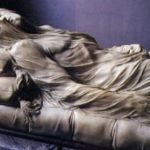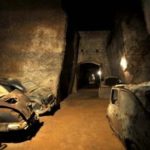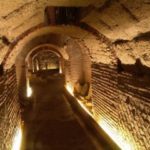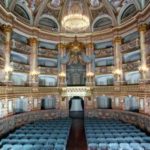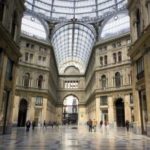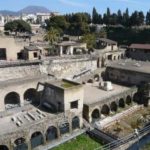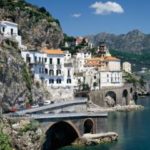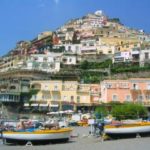On the ancient island of Megaride stands the imposing Castel dell ‘Ovo. One of the most imaginative legends Neapolitan would trace its name to the egg that Virgil would have hidden inside a cage in the basement of the castle. The place where the egg was kept was closed with heavy locks and kept secret because of “quell’ovo hung them all facti and the fortune of Castel Marino” From that moment the fate of the castle, together with that of the entire city of Naples, has been linked to that of the egg. The chronicles report that, at the time of Queen Joanna I, the castle suffered considerable damage due to the collapse of the arch that joins the two rocks on which it is built and the Queen was forced to declare solemnly that he had taken steps to replace the egg to prevent it from spreading panic in the city for fear of new and more serious disasters. The Castle of the Egg, now headquarters of the Region for Cultural Heritage and Landscape of Campania, has been, over time, of many changes, traces of which are still evident today. Kingdom at the Castle on the side of the sea, the Ramaglietto was built above the old “side of the Sun”, where once there were windmills. The viceroy Bonavides Francis Earl of St. Stephen, at the end of the seventeenth century, ordered its construction to defend the castle from the enemy fleet. Done in stages between 1691 and 1693, the fort was able to contain up to sixty pieces of artillery, owing to its remarkable extension to the sea. From Ramaglietto, through a walkway that runs along the castle, we arrive at the natural than in the past, open to the sea, identified the image of the islet. L ‘arc, which collapsed during the reign of Joan of Anjou, was rebuilt in masonry. Its amplitude is read today inside the Italian room. The only internal road through one of the towers still visible, that of Normandy, built by William the Bad in defense of the most vulnerable point of the islet to the sea. The tower, on which were hoisted the flags, rests on arches piperno and retains traces of the battlement, incorporated in a subsequent elevation. After the tower, you go to one of the two sacred buildings of the islet, the Church of the Saviour, whose share remained intact today has a side access. The structure rests on tall granite columns and plain capitals, of Roman origin. All ‘inside are the remains of the late Byzantine frescoes. The Church of St. Peter, there remains no trace visible, but the presence of places of worship brings to mind the religious purpose of the islet. Of the monastic complex inhabited by Basilian monks and nuns first order of Santa Patrizia then, are the ‘hermitages’, chambers dug into the tuff rock. States by a thick trail of tunnels, have been brought to light, in their entirety, at the beginning of the twentieth century. Some cells are simple cavity dug into the tuff, others have brick walls and vaulted ceiling, probably used as altars. In some environments, there are traces of frescoes rudimentary, made of a plaster more accurately, today, almost illegible. The cell is the most decorated of Santa Patrizia. Among the most striking of the Castle, the Hall of Columns owes its name to the numerous bare columns reused in the structure, resting on arches. The drums with sharp-edged flutes, are clearly legible as part of larger columns and stand out in their marble whiteness in contrast with the yellow tuff. Divided into aisles, the room looks like the structure of a church, but most likely it was used for the refectory of the monks. The materials of bare, variously reused in different structures of the castle, reminiscent of the magnificent villa, built in the first century BC by the Roman Consul Lucius Licinius Lucullus. Near the entrance bastion there is a large restaurant is housed in the tufa, which over the centuries has assumed the name of “Prison of the Queen Giovanna”. The environment, today known as the Hall of Prisons, consists of a large central compartment, from which radiate corridors leading to the open windows on the east and west sides of the castle. For the width of the enclosure and the form, it is conceivable origin as a fortification of the castle. Subsequently, under the Norman domination, the Hall of Prisons was used for the custody of the treasures and documents, including the secret archives of the State. The Castel dell ‘Ovo there is also the seat of the Italian Castle, section Campania. The venue is only open by appointment. And ‘possible to visit a photographic exhibition on the architecture of the fortified Campania. From the ramparts of the Castle and its terraces you can enjoy a lovely view of the bay, which offers visitors a unique view of the city. The Castle of the Egg, as well as being a prestigious, is a candidate for the beauty of the area and the easy accessibility, to be the ideal venue for conferences and prestigious exhibitions. At the Castle can also be made photo shoots and movies for personal use related to ceremonies (weddings, communions etc.). Castle of the Egg are located within different rooms and spaces, of various types, which can be used for conferences, meetings and business meetings. The rooms and spaces are bare to allow the preparations according to the needs of each user. The exhibition, then, like any catering connected to it, is the responsibility of the organizers who can choose freely among the specialized companies in the field.




